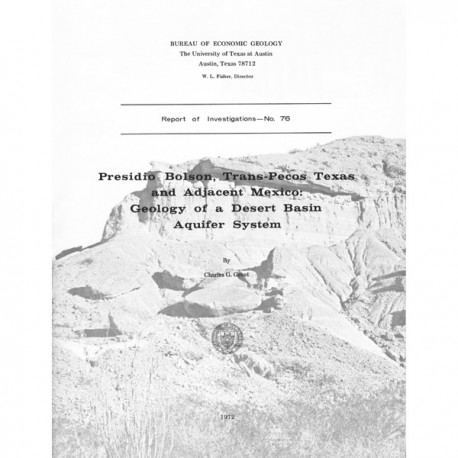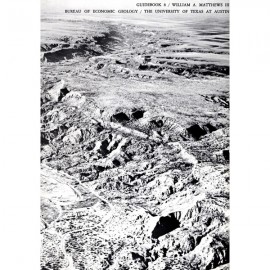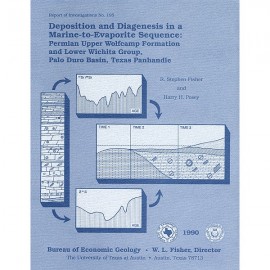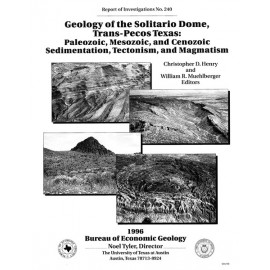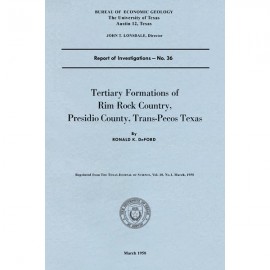Reports of Investigations
-
Books & Reports
- Reports of Investigations
- Guidebooks
- Udden Series
- Geological Circulars
- Down To Earth
- Atlases of Major Oil and Gas Reservoirs
- Texas Memorial Museum Publications
- Environmental Geologic Atlas of the Texas Coastal Zone
- Mineral Resource Circulars
- Other Reports
- Seminars and Workshops
- Handbooks
- Submerged Lands of Texas
- Symposia
- Annual Reports
- Open File Reports
-
Maps & Cross Sections
- Thematic Maps
- Miscellaneous Maps, Charts & Sections
- Geologic Atlas of Texas
- STATEMAP Project Maps
- Geologic Quadrangle Maps
- Cross Sections
- Highway Geology Map
- Energy and Mineral Resource Maps
- Shoreline Change and Other Posters
- Wilcox Group, East Texas, Geological / Hydrological Folios
- Bouguer Gravity Atlas of Texas
- River Basin Regional Studies
- Featured Maps
- Posters
- Teachers & the Public
-
Geological Society Publications
- Gulf Coast Association of Geological Societies
- Alabama Geological Society
- Austin Geological Society
- Corpus Christi Geological Society
- Houston Geological Society
- Lafayette Geological Society
- Mississippi Geological Society
- New Orleans Geological Society
- South Texas Geological Society
- GCS SEPM Publications
- Historic BEG & UT Series
Presidio Bolson, Trans-Pecos Texas, and Adjacent Mexico: Geology of a Desert Basin Aquifer System
RI0076
Presidio Bolson, Trans-Pecos Texas and Adjacent Mexico: Geology of a Desert Basin Aquifer System, by C. G. Groat. 46 p., 21 figs., 1 plate, 1972. ISSN:0082335X:Print. Print Version.
A free, digital version of this publication can be found on: Texas ScholarWorks
RI0076. Presidio Bolson, Trans-Pecos Texas and Adjacent Mexico: Geology of a Desert Basin Aquifer System, by C. G. Groat. 46 p., 21 figs., 1 plate, 1972. ISSN:0082335X:Print.
To purchase this publication as a downloadable PDF, please order RI0076D.
ABSTRACT
Mountain-bounded basins or bolsons are the most important aquifer systems throughout most of southwestern and western United States and northern Mexico. The dissection of the Presidio Bolson by the Rio Grande and its tributaries has afforded an ideal situation for detailed study of the stratigraphy of one of these important aquifer systems. The results of this investigation provide a framework for understanding the relationships between the types and distribution of bolson-fill sediments and the occurrence of ground water in desert basins in the United States and Mexico.
The Presidio Bolson formed by middle Tertiary normal faulting; the basin was filled with detritus shed from the surrounding mountains. Poorly sorted conglomerate and interbedded sandstone deposited on alluvial fans characterize the basin-margin facies; gypsiferous mudstone and fine sandstone of the basin-center facies, the greatest volume of deposits, were deposited on the toes of alluvial fans, in ephemeral playa lakes, and in relatively permanent lakes.
Excavation of the bolson fill began, probably during the Pleistocene, when the bolson was integrated into a regional, degradational drainage system with the Rio Grande as a master stream. Tributaries or sidestreams have been the dominant elements in dissection of the bolson fill; spectacular steplike abandoned erosion surfaces, cut by these streams by lateral planation, are the most striking features in the modern landscape. The high, prominent surfaces were cut by large sidestreams, transporting gravel, that head outside the bolson in the surrounding mountains; the gravel forms a cap that protects the surfaces from further dissection. Low, irregular, discontinuous surface remnants characterize areas drained by numerous smaller streams that head in fine-grained bolson fill.
The steplike arrangement of the surface remnants is at least in part caused by the interaction of sidestream processes with lateral migration of the Rio Grande channel-floodplain complex and by commonly occurring sidestream captures. The Rio Grande swings laterally, trimming back sidestream valley floors and creating sidestream terraces; the heights of these terraces above the Rio Grande are determined by the sidestream valley-floor gradients and the distance the mainstream swings. Capture of high-gradient, gravel carrying, large sidestreams by lower-gradient streams heading in the fine-grained bolson fill produces abandoned, gravel-floored valleys that become high erosion-surface remnants. The role of pauses in downcutting, related to Pleistocene climatic changes, in producing the stepped surface remnants is not clear. Probably it was not great.
Ground water is the most valuable resource in the basin. The most reliable supplies are obtained from Rio Grande alluvium south of the juncture with the Rio Conchos. Sidestream alluvium yields small quantities of water in a few places. The bolson fill is potentially the most important aquifer, but the large plug of impermeable, gypsiferous mudstone results in small yields of poor-quality water over much of the bolson.
Keywords: alluvium, aquifers, bolsons, groundwater, Pleistocene, Presidio Bolson, Rio Grande, Texas, Trans-Pecos Texas
Citation
Groat, C. G., 1972, Presidio Bolson, Trans-Pecos Texas and Adjacent Mexico: Geology of a Desert Basin Aquifer System: The University of Texas at Austin, Bureau of Economic Geology, Report of Investigations No. 76, 46 p.
